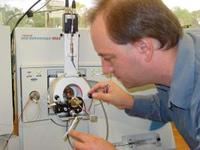We usually think of nanotechnology as being the chemistry of custom-designed materials. Like Buckytubes.
But it’s much more. It’s really a new investigative technique, the parsing of complex chemicals into their constituent parts, and the examination of both those parts and the patterns which they have in living organisms.
Take this example. It’s not from Rice. (Surprise.)
It’s from the University of Buffalo. (Go Bulls.) It’s the discovery of a peptide "fingerprint" common in all sufferers from ALS, sometimes called Lou Gehrig’s disease by those seeking money for it, but known to the Irish (like my great-aunt who died from it) as "turn to stone" because that’s what it does.
ALS literally turns sufferers into stone, unable to control their muscles, just waiting for the heart attack which hits when the disease gets to the final, big muscle. A horrible way to die.
Researchers had found an unknown protein species in samples of spinal
fluid, but all they had to work with was found in nanogram quantities.
Standard techniques could not be used.
So they used what’s called a nanospray emitter, which allows analysis
of such small samples, and found the same protein signature in patients
with a family history of the disease and those without such a history.
Troy Wood of UB developed the emitter, which he calls NiagaraFlow. (Cute name. Very punny.) Wood has launched a company called Nanogenesys
to commercialize the emitter. (It’s U.S. Patent number 6,670,607 for
those scoring at home.) But now they have a common link among ALS
patients which can lead to further study. How does the peptide develop?
Does fighting the peptide fight the disease?
Stay tuned.
The point is that nanotech is more than materials science. It is, in many ways, a new way to do science. And its successes do not just lie in new materials, but in new techniques, sometimes in new inventions.
Which can come from anywhere.











